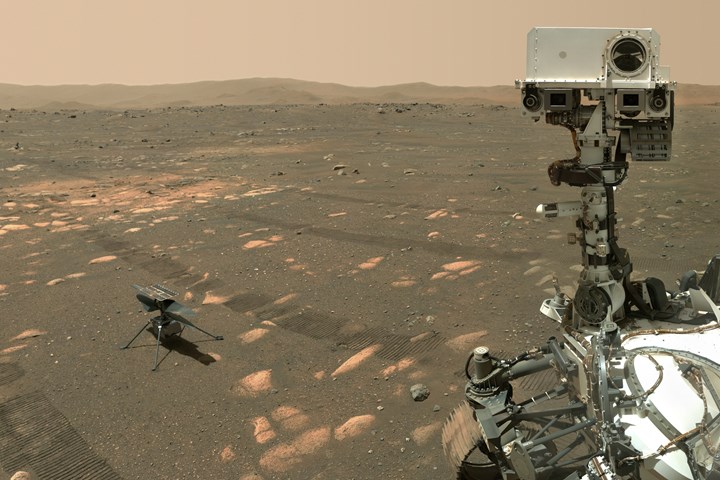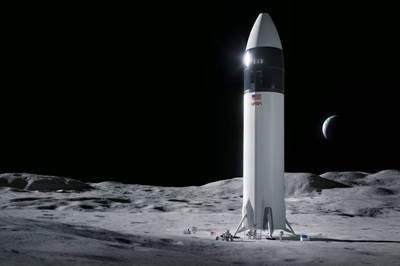Ingenuity helicopter begins new demonstration phase
Proving its mettle at controlled, powered flight on Mars, Ingenuity’s transition to an operations demonstration phase will bring a new flight envelope, and perform aerial observations for future missions.

NASA’s Perseverance Mars rover took a selfie with the Ingenuity helicopter, seen here about 13 feet (3.9 meters) from the rover in this image taken April 6, 2021. Photo Credit: NASA/JPL-Caltech/MSSS
NASA reports that its Ingenuity Mars Helicopter has a new mission. Having proven that powered, controlled flight is possible on the red planet (see “AeroVironment celebrates composite-intensive Ingenuity Helicopter flight on Mars”), the Ingenuity experiment will soon embark on a new operations demonstration phase, exploring how aerial scouting and other functions could benefit future exploration of Mars and other worlds.
This new phase will begin after the helicopter completes its next two flights. The decision to add an operations demonstration is a result of the Perseverance rover being ahead of schedule with the thorough checkout of all vehicle systems since its Feb. 18 landing, and its science team choosing a nearby patch of crater bed for its first detailed explorations. With the Mars Helicopter’s energy, telecommunications and in-flight navigation systems performing beyond expectation, an opportunity arose to allow the helicopter to continue exploring its capabilities with an operations demonstration, without significantly impacting rover scheduling.
“The Ingenuity technology demonstration has been a resounding success,” says Thomas Zurbuchen, associate administrator for NASA’s Science Mission Directorate. “Since Ingenuity remains in excellent health, we plan to use it to benefit future aerial platforms while prioritizing and moving forward with the Perseverance rover team’s near-term science goals.”
The operations demonstration will begin in about two weeks with the helicopter’s sixth flight. Until then, NASA says Ingenuity will be in a transitional phase that includes its fourth and fifth forays into Mars’ crimson skies. Flight four will send the composite rotorcraft about 436 feet (133 meters) south to collect aerial imagery of a potential new landing zone before returning to land at Wright Brothers Field, the name for the Martian airfield on which Ingenuity’s first flight took place. This 873-foot (266-meter) roundtrip effort would surpass the range, speed, and duration marks achieved on the third flight. According to NASA, Ingenuity was programmed to execute a fourth flight Friday, April 30, with a takeoff to take place at 10:46 a.m. EDT (7:46 a.m. PDT, 12:30 p.m. local Mars time) and first data to be returned at 1:39 p.m. EDT (10:39 a.m. PDT). The fifth flight would send Ingenuity on a one-way mission, landing at the new site. If Ingenuity remains healthy after those flights, the next phase can begin.
Change of course
Ingenuity’s transition from conducting a technology demonstration to an operations demonstration brings with it a new flight envelope, reports NASA. Along with those one-way flights, there will be more precision maneuvering, greater use of its aerial-observation capabilities and more risk overall.
The change also means Ingenuity will require less support from the Perseverance rover team, which is looking ahead for targets to take rock and sediment samples in search of ancient microscopic life. On April 26 — the mission’s 66th sol, or Martian day — Perseverance drove 33 feet (10 meters) with the goal to identify targets.
“With the short drive, we have already begun our move south toward a location the science team believes is worthy of investigation and our first sampling,” says Ken Farley, project scientist for the Perseverance rover from Caltech in Pasadena, Calif. “We’ll spend the next couple of hundred sols executing our first science campaign looking for interesting rock outcrop along this 2-kilometer (1.24-mile) patch of crater floor before likely heading north and then west toward Jezero Crater’s fossil river delta.”
With short drives expected for Perseverance in the near term, Ingenuity may execute flights that land near the rover’s current location or its next anticipated parking spot. The helicopter can use these opportunities to perform aerial observations of rover science targets, potential rover routes and inaccessible features while also capturing stereo images for digital elevation maps. The lessons learned from these efforts will reportedly provide significant benefit to future mission planners. These scouting flights are a bonus and not a requirement for Perseverance to complete its science mission.
The cadence of flights during Ingenuity’s operations demonstration phase will slow from once every few days to about once every two or three weeks, and the forays will be scheduled to avoid interfering with Perseverance’s science operations. The team will assess flight operations after 30 sols and will complete flight operations no later than the end of August. That timing will allow the rover team time to wrap up its planned science activities and prepare for solar conjunction — the period in mid-October when Mars and Earth are on opposite sides of the sun, blocking communications.
“We have so appreciated the support provided by the Perseverance rover team during our technology demonstration phase,” adds MiMi Aung, project manager of Ingenuity at NASA’s Jet Propulsion Laboratory (JPL) in Southern Calif. “Now we have a chance to pay it forward, demonstrating for future robotic and even crewed missions the benefits of having a partner nearby that can provide a different perspective — one from the sky. We are going to take this opportunity and run with it — and fly with it.”
Related Content
Manufacturing the MFFD thermoplastic composite fuselage
Demonstrator’s upper, lower shells and assembly prove materials and new processes for lighter, cheaper and more sustainable high-rate future aircraft.
Read MoreThe potential for thermoplastic composite nacelles
Collins Aerospace draws on global team, decades of experience to demonstrate large, curved AFP and welded structures for the next generation of aircraft.
Read MoreA new era for ceramic matrix composites
CMC is expanding, with new fiber production in Europe, faster processes and higher temperature materials enabling applications for industry, hypersonics and New Space.
Read MoreWelding is not bonding
Discussion of the issues in our understanding of thermoplastic composite welded structures and certification of the latest materials and welding technologies for future airframes.
Read MoreRead Next
NASA selects SpaceX to head human lander development for Artemis moon mission
HLS to act as final mode of transportation to take astronauts to the lunar surface for the Artemis program, with potential future travel to Mars and other destinations.
Read MoreVIDEO: High-volume processing for fiberglass components
Cannon Ergos, a company specializing in high-ton presses and equipment for composites fabrication and plastics processing, displayed automotive and industrial components at CAMX 2024.
Read More“Structured air” TPS safeguards composite structures
Powered by an 85% air/15% pure polyimide aerogel, Blueshift’s novel material system protects structures during transient thermal events from -200°C to beyond 2400°C for rockets, battery boxes and more.
Read More

























